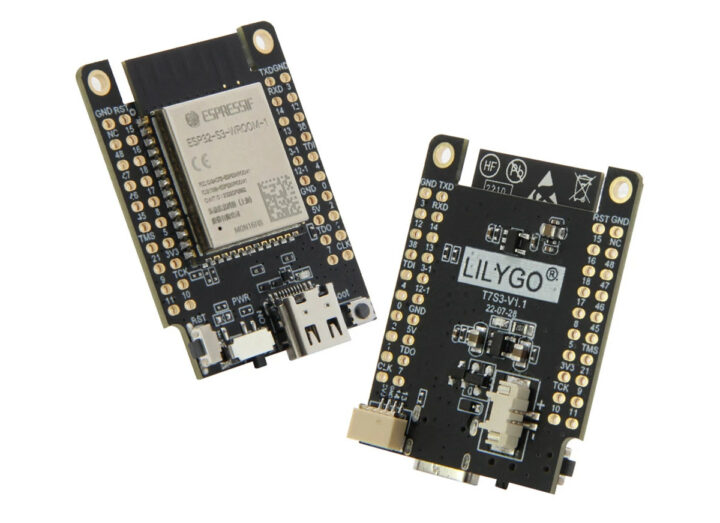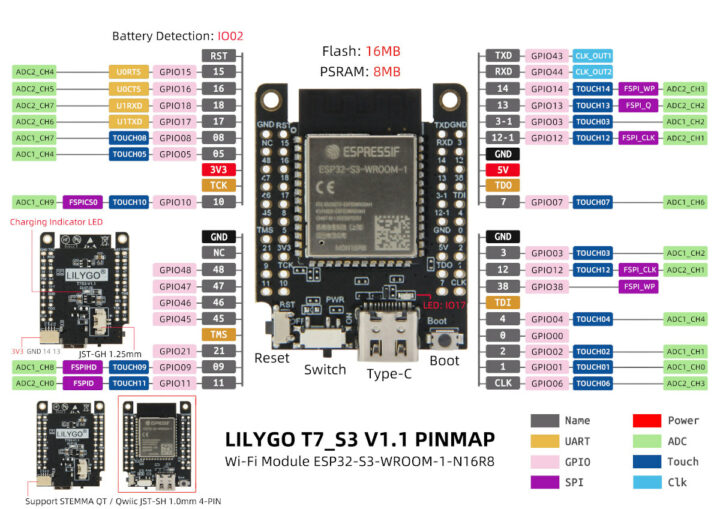LILYGO has launched another ESP32-S3 development board. The T7-S3 is equipped with an ESP32-S3-WROOM-1 module with 16MB flash, 8MB PSRAM, and a PCB antenna.
The board is fairly compact at 3.9×3.1 cm, can be powered through a USB-C port or a LiPo battery with charging support, and offers 40 through holes plus a Qwicc/QT I2C connector for expansion.
LILYGO T7-S3 specifications:
- Wireless module – ESP32-S3-WROOM-1-N16R8 module with
- SoC – Espressif Systems ESP32-S3 dual-core Xtensa LX7 processor @ up to 240 MHz integrating vector instructions for AI acceleration, 512 KB SRAM, WiFi 4 and Bluetooth 5.0 LE & Mesh connectivity
- Memory – 8MB PSRAM
- Storage – 16MB SPI Flash
- USB – USB Type-C port
- Expansion
- 2x 20-pin headers with up to 29x GPIOs, 20x ADC, UART, SPI, Touch interface, 5V, 3.3V, and GND
- 4-pin Qwiic/QT I2C connector
- Misc – User LED, charging LED (blue), reset and boot buttons, power on/off switch
- Power Supply
- 5V via USB-C port
- 2-pin JST connector for LiPo battery with charging support
- Dimensions – 3.9 x 3.1 x 0.6 cm
The company provides very basic instructions to get started with PlatformIO, the Arduino IDE, and MicroPython, as well as two simple Arduino sketches, one to enter deep sleep and the other to read battery voltage continuously and switch the user LED on and off if a button is pressed.
They are also showing 34.64uA power consumption in deep sleep mode with the battery connected (so around 3.7 to 4.2V) demonstrating the low power consumption of the ESP32-S3. I suppose it’s not too bad, but other ESP32-S3 boards have been shown to consume even less, and for example, the Unexpected Maker TinyS3 has been measured at 27.29 uA @ 4.2V using Nordic Semi’s Power Profiler Kit II for measurement.
LILYGO currently sells the T7-S3 for $11.98 with free shipping, but since Aliexpress 11.11 event is starting in about 2 days, the board will be offered for just $9.58 during the event, that’s provided it is still in stock at the time of the promotion…

Jean-Luc started CNX Software in 2010 as a part-time endeavor, before quitting his job as a software engineering manager, and starting to write daily news, and reviews full time later in 2011.
Support CNX Software! Donate via cryptocurrencies, become a Patron on Patreon, or purchase goods on Amazon or Aliexpress






Misleading price info. Shame on you lilygo. See screenshot just taken.
Now on Aliexpress, price depends on your country as they are now adding the mandatory VAT for Eu, for example.
This would be nice if the second USB port was broken out, like the ESP32-S3-DevKitC-1 v1.1 series.[1] The additional USB port supports OTG. But if small size and low cost matter most, and possibly long ship times from China are OK, then the LILYGO T7-S3 is a good option. By the way the AliExpress page says: “LILYGO® T7 S3 ESP32-S3 Development Board WIFI Bluetooth 5.0 ESP32-S3-WROOM-1 Module 16MB Flash 32-bit RISC-V MCU 8MB PSRAM”. That is wrong. The ESP32-S3 does not use a single core RISC-V MCU, that is the ESP32-C3. Instead the ESP32-S3 uses the Tensilica Xtensa LX7 dual-core MCU, up to 240 MHz per core. Finally my AliExpress 11.11 pricing shows $10.38 USD, not “under $10.00”. But that may be higher because I am shipping to the U.S. It’s a small difference; still a reasonable deal.
* References:
1. ESP32-S3-DevKitC-1 v1.1
https://docs.espressif.com/projects/esp-idf/en/latest/esp32s3/hw-reference/esp32s3/user-guide-devkitc-1.html
Is there a power distribution module like in the Lora/Gps Meshtastic? That allowed really programming the power usage but it only had like one or two free pins after running all the devices (I might recall incorrectly).
The second USB-port? The ESP32-S2 and ESP32-S3 both only have one USB peripheral, not two. The reason there are two USB-ports on the official DevKitC is because there’s a USB-TTL-chip there, connected to the UART-pins.
There is still a RISC-V ultra-low power core (for deep sleep mode), but you are true, there are 2 LX7 MCU. I would like to see soon a ESP32 with 2 RISC-V cores + 1 RISC-V ULP core :).
The difference in deep sleep current is probably just their choice of the LDO on board. An ~8uA difference fits quite nicely within the range of quiescent current typical low-power LDOs seem to have.
Do note how neither company mention how much current the LDO used can supply on their product pages or even what the LDO is; you have to dig into the schematics to find that out and there’s no schematics available for the Lilygo-board yet.
“Do note how neither company mention how much current the LDO used can supply on their product pages “
Not true – I list 700mA for LDO output on my features list and the board features images for all of my boards.
See image here…
https://esp32s3.com/images/main_features_tinys3.jpg
Ah, I totally missed that.
All good 🙂
Already out of stock. I can’t seem to ever get my hands on anything anymore lately. Chip shortage really needs to be fixed asap.
I am making the transition from the T7 V1.3 board to the new T7_S3 boards and would like some assistance with I2C communication pins (SDA & SCL0) recommended assignment. I am currently using pins 21 = SDA & 22 = SCL with the T7 V1.3 boards, what is recommended with the new T7_S3 boards?